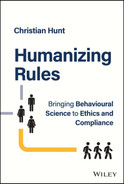CHAPTER 17
THE SIX RULES
Introduction
Since this book’s title contains the word Rules, I thought we should have some. In each of the following six chapters, I will introduce you to a rule. Keeping with the book's spirit, they are not intended to be slavishly followed.
The rules are simply a means of highlighting common misconceptions about how we can best influence our employees. We can avoid making unnecessary mistakes and identify creative alternatives to solving our compliance challenges by being aware of them.
Rule One: Compliance Is an Outcome, Not a Process
In the same way that we rely on biases and heuristics to guide our thinking, we tend to lean on “tried and tested” processes when delivering compliance outcomes. Rule Number One encourages us to take a step back and think about what outcome we want to achieve. That way, we can choose the right tool for the job.
Rule Two: 100% Compliance Is Neither Achievable Nor Desirable
We often hear the phrase “zero tolerance” in relation to particular rules or requirements. While that sounds sensible, it isn't always realistic. In some cases, it can even be counter‐productive. Rule Number Two highlights why and encourages us to think carefully about what outcome we actually need.
Rule Three: When Putting on a Show, Make Sure You Know Your Audiences
Very often, when trying to persuade people to behave in a particular manner, we do things for effect. That might mean showing a regulator how seriously we're taking their rules or making a control highly visible to deter wrongdoers. Rule Number Three encourages us to think about who our audiences are, what messages we might want to send them, and how we can avoid inadvertently sending unhelpful messages to unintended audiences.
Rule Four: Design for the Willing, Not the Wilful
When writing rules, we tend to think about the “bad” outcomes we're trying to prevent, and the “bad” people were trying to deter. That means we're not thinking about the vast majority of people who want to do the right thing. Rule Number Four encourages us to focus our efforts on them.
Rule Five: If One Person Breaks a Rule, You've Got a People Problem; If Lots of People Break a Rule, You've Got a Rule Problem
When people break a rule within an organisation, we rightly hold them accountable. But if many people are breaking that same rule, then it's unlikely they're all deliberately setting out to do so. It's more likely that the rule has something about it that is driving noncompliance. Rule Number Five helps us to think about why and what we can do about it.
Rule Six: Just Because You Can Doesn't Mean You Should
When deciding on a course of action or explaining it in hindsight, we can often turn to whether it is legal or otherwise permitted to justify what we do or have done. This applies to us as rule‐setters. We can legally require many things of our employees, but is it correct or practical for us to always do so? It also applies to our employees. There are lots of things they are permitted or able to do. But should they? Rule Number Six explores these dynamics and how we can think about mitigating them.
